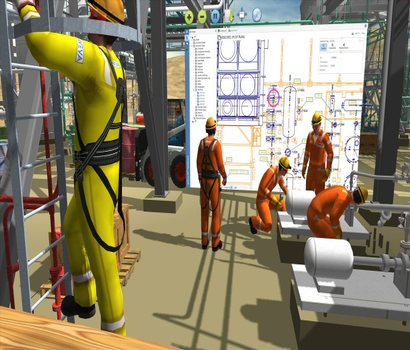Introduction
The Oil & Gas industry has faced many challenges over the years, but the difficulty to explore and produce more commercially feasible hydrocarbon continues. However, with new technologies and next-gen platforms, opportunities to innovate, expand and transform the industry are in full force.
Use of VR in the Oil & Gas Industry
Virtual Reality (VR)
Virtual Reality (VR) indicates a computer-generated stimulation where the users may inhabit an artificial three-dimensional environment using electronic devices like special goggles/headgears fitted with sensors. The stimulation could be an animated scene or an actual location photographed and embedded to form a virtual reality. VR creates a completely immersive experience. It is used widely in the entertainment and gaming industries or as an educational, sales, or training tool.
Virtual realities create an artificial sensory experience through graphics, audio, and haptic feedback. VR technology can help in the creation of a virtual environment involving mines, a city, or an oil reservoir. It allows the users to walk through these environments and execute what-if situations.
The Oil & Gas industry has the potential to adapt VR-based tools. The success of the exploration process profoundly depends on the interpretation of information. Virtual reality platforms provide additional insights by creating an immersive environment to visualize and decipher the data. The new generation of VR technologies offers greater flexibility and cost settlement.
The Virtual Reality tools can be made available at the rig site or field site for performing operations. For example, a driller wearing VR gear to track drilling paths is virtually accommodated with real-time information about the reservoir.
The VR application for Oil & Gas is a 3D immersive technology. It takes a sub-surface level earth model, plugs it into the headgear to provide an enriching experience on-the-move. It allows the user to view wells, reservoirs, geological formations, seismic traces, etc.
The comprehensive static earth model containing structural data such as zones and layers, logs, deviation surveys, faults, and horizons is loaded onto the VR headgear. The subsurface data is available to field users like drilling engineers, site geologists, supervisors, production and reservoir engineers on-site to enhance decision making during dire drilling operations.
SES Digital’s VR services for Oil & Gas industry
SES Digital’s immersive walkthrough acquires a comprehensive view of the site. By gathering data such as images, videos, or animations, we create real-time 3D experiences with VR from 2D/3D CAD models. With the help of innovative technologies, our team fulfils the gap between design and actuality. Our system records installation walk-throughs that can be replayed later. The users can adjust the speed, viewing perspective, and eye height. Our services include interior and exterior spaces, space planning, conceptual planning, and the development of collaborative VR applications for stimulation walkthroughs.
Our VR application supports features like zoom in, zoom out, and the model can be viewed from various directions. Along with a well-planned path, the actual path is overlaid to show any deviation from the actual route as drilling progresses. All users responsible for drilling on and off-site can visualize the same data on their respective headgears too. Hardware such as laptops or computers is not required for such visualization.
We use dynamic stimulators which are used in gaming to test and train the engineers for working in a complex environment. These stimulators create actual plant operating surroundings to provide realistic training settings like workforce development, new hire orientation, competency assurance, efficient turnaround, or shutdown planning.
Conclusion
AR exists with graphical overlays but is not a fully immersive experience. But the VR applications are an ultra-realistic, multi-angle immersive technology that can be used by operators, engineers, and supervisors in Oil & Gas production, processing and transportation facilities. They also provide assistance in the training process. Multiple prototypes prove that virtual reality concepts make Oil & Gas operations more efficient.

